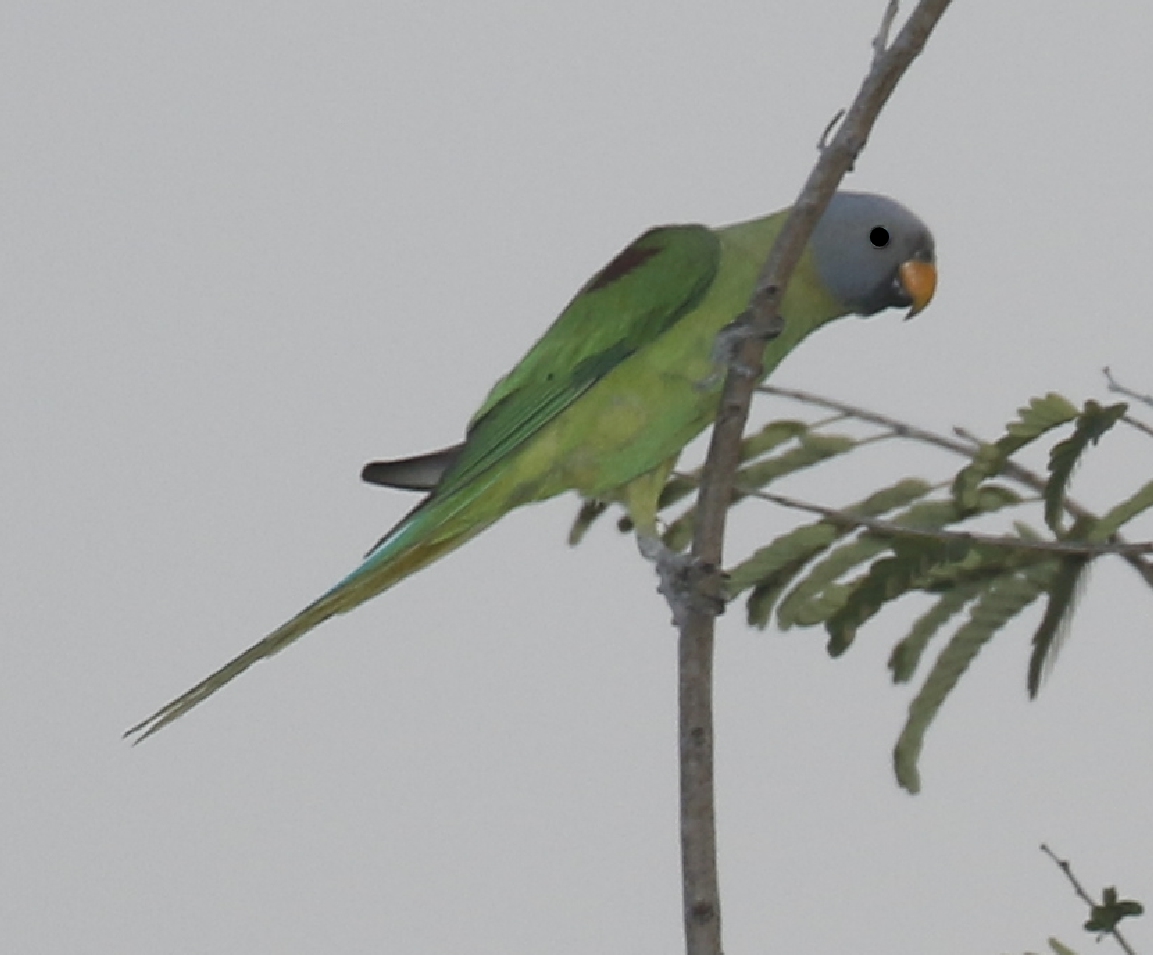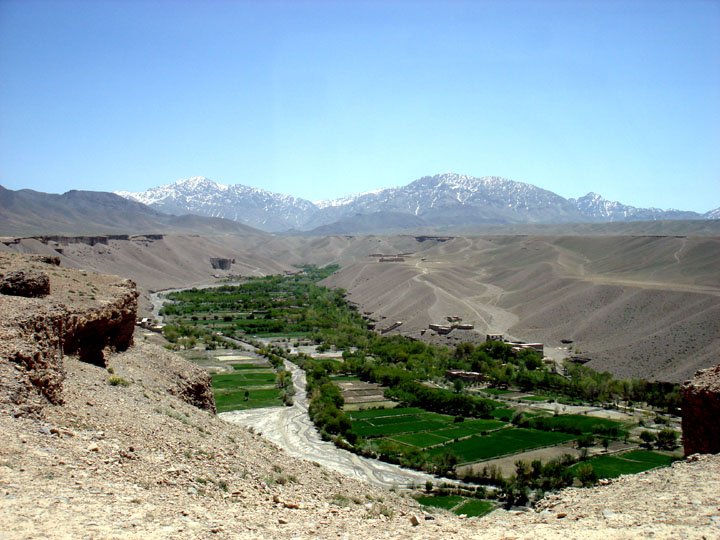|
Slaty-headed Parakeet
The slaty-headed parakeet (''Psittacula himalayana'') is the only psittacid species to exhibit altitudinal migration. The species' range extends from Pakistan, to Western Himalayas in India through Nepal and Bhutan and up to the Eastern Himalayas in the northeastern Indian state of Arunachal Pradesh. They descend to the valleys in winter, approximately during the last week of October. Description Adults of both genders have green (tinted with blue) feathers on most of their body. It has a dark grey (slate colored) head with a light blue tint where head meets the neck. Males feature dark maroon patches on inner wing coverts. Females do not feature these maroon patches. Males have long central tail feathers which are shorter in female birds. The tail is green at base and becomes deep blue and widely tipped with bright yellow. The parakeet features a bright red-orange upper mandible with a pale yellow lower. It also has a pale yellow eye. Distribution and population The slaty-he ... [...More Info...] [...Related Items...] OR: [Wikipedia] [Google] [Baidu] |
Kullu
Kullu is a municipal council town that serves as the administrative headquarters of the Kullu district of the states and union territories of India, Indian state of Himachal Pradesh. It is located on the banks of the Beas River in the Kullu Valley about north of the airport at Bhuntar, Bhuntar, Kullu. Kullu Valley is a broad open valley formed by the Beas River between Manali, Himachal Pradesh, Manali and Larji. This valley is known for its temples and its hills covered with pine and Cedrus deodara, deodar forest and sprawling apple orchards. The course of the Beas river, originating from Beas Kund presents a succession of magnificent, clad with forests of deodar, towering above trees of pine on the lower rocky ridges brings the most out of this magnificent town. Kullu Valley is sandwiched between the Pir Panjal Range, Pir Panjal, Lower Himalayan and Great Himalayas, Great Himalayan Ranges, located in Northern India, 497 k.m. away from the capital of India. History Historica ... [...More Info...] [...Related Items...] OR: [Wikipedia] [Google] [Baidu] |
Jammu And Kashmir (union Territory)
Jammu and Kashmir is a region administered by India as a union territory and consists of the southern portion of the larger Kashmir region, which has been the subject of a dispute between India and Pakistan since 1947, and between India and China since 1962.(a) (subscription required) Quote: "Kashmir, region of the northwestern Indian subcontinent ... has been the subject of dispute between India and Pakistan since the partition of the Indian subcontinent in 1947. The northern and western portions are administered by Pakistan and comprise three areas: Azad Kashmir, Gilgit, and Baltistan, the last two being part of a territory called the Northern Areas. Administered by India are the southern and southeastern portions, which constitute the state of Jammu and Kashmir but are slated to be split into two union territories. China became active in the eastern area of Kashmir in the 1950s and has controlled the northeastern part of Ladakh (the easternmost portion of the region) sinc ... [...More Info...] [...Related Items...] OR: [Wikipedia] [Google] [Baidu] |
Psittacula
Members of the parrot genus ''Psittacula'' or Afro-Asian ring-necked parrots they are commonly known in aviculture originate from Africa to South-East Asia. It is a widespread group with a clear concentration of species in south Asia, but also with representatives in Africa and the islands of the Indian Ocean. This is the only genus of Parrot which has the majority of its species in continental Asia. Of all the extant species only '' Psittacula calthropae'', ''Psittacula caniceps'' and ''Psittacula echo'' do not have a representative subspecies in any part of mainland continental Asia. The rose-ringed parakeet, ''Psittacula krameri'', is one of the most widely distributed of all parrots. The other two Asian genera, '' Loriculus'' and ''Psittinus'' are represented by only two species each, which occur in the mainland part of Asia. The majority of the ''Loriculus'' species occur on islands. Moreover, since ''Loriculus'' is spread across both sides of the Wallace Line it can be consi ... [...More Info...] [...Related Items...] OR: [Wikipedia] [Google] [Baidu] |
Scaly-bellied Woodpecker
The scaly-bellied woodpecker (''Picus squamatus'') is a species of bird in the family Picidae. It is found in the Indian subcontinent and adjoining regions, ranging across Afghanistan, Iran, India, Nepal, Pakistan, and Turkmenistan. Habitat Its natural habitats are boreal forest A forest is an area of land dominated by trees. Hundreds of definitions of forest are used throughout the world, incorporating factors such as tree density, tree height, land use, legal standing, and ecological function. The United Nations' ...s, temperate forests, and subtropical or tropical moist lowland forests. Description Large, green woodpecker with distinct scaling from breast to vent. Similar to streak-throated woodpecker but larger and with unstreaked throat and upper breast. Black moustache and black bored white supercilia. Tail strongly barred. Crown red in male, blackish in female. Large pale bill. References scaly-bellied woodpecker Birds of Afghanistan Birds of North India ... [...More Info...] [...Related Items...] OR: [Wikipedia] [Google] [Baidu] |
Incubation Period
Incubation period (also known as the latent period or latency period) is the time elapsed between exposure to a pathogenic organism, a chemical, or radiation, and when symptoms and signs are first apparent. In a typical infectious disease, the incubation period signifies the period taken by the multiplying organism to reach a threshold necessary to produce symptoms in the host. While ''latent'' or ''latency period'' may be synonymous, a distinction is sometimes made whereby the latent period is defined as the time from infection to infectiousness. Which period is shorter depends on the disease. A person may carry disease, such as ''Streptococcus'' in the throat, without exhibiting any symptoms. Depending on the disease, the person may or may not be contagious during the incubation period. During latency, an infection is subclinical. With respect to viral infections, in incubation the virus is replicating. This is in contrast to viral latency, a form of dormancy in which the v ... [...More Info...] [...Related Items...] OR: [Wikipedia] [Google] [Baidu] |
Blossom-headed Parakeet
The blossom-headed parakeet (''Psittacula roseata'') is a parrot in the family Psittaculidae. Taxonomy The species is divided into two subspecies: *''Psittacula roseata juneae'' Biswas, 1951 (S Myanmar and Thailand to Laos, Cambodia and Vietnam) *''Psittacula roseata roseata'' Biswas, 1951 (N India to Bhutan, Bangladesh and N Myanmar) Distribution and habitat This species is a resident breeder in Eastern Bangladesh, Bhutan, Northeast India and Nepal, eastwards into South-east Asia (Cambodia, Laos, Myanmar, Thailand and Viet Nam) and also China. Blossom-headed parakeet inhabits lowland and foothill open forests and forest edges. ebird Description [...More Info...] [...Related Items...] OR: [Wikipedia] [Google] [Baidu] |
Plum-headed Parakeet
The plum-headed parakeet (''Psittacula cyanocephala'') is a parakeet in the family Psittacidae. It is endemic to the Indian Subcontinent and was once thought to be conspecific with the blossom-headed parakeet (''Psittacula roseata'') but was later elevated to a full species. Plum-headed parakeets are found in flocks, the males having a pinkish purple head and the females, a grey head. They fly swiftly with twists and turns accompanied by their distinctive calls. Taxonomy In 1760 the French zoologist Mathurin Jacques Brisson included a description of the plum-headed parakeet in his ''Ornithologie'' based on a specimen collected in India. He used the French name ''Le perruche a teste bleu'' and the Latin name ''Psittaca cyanocephalos''. The two stars (**) at the start of the section indicates that Brisson based his description on the examination of a specimen. Although Brisson coined Latin names, these do not conform to the binomial system and are not recognised by the Internationa ... [...More Info...] [...Related Items...] OR: [Wikipedia] [Google] [Baidu] |
Rose-ringed Parakeet
The rose-ringed parakeet (''Psittacula krameri''), also known as the ring-necked parakeet (more commonly known as the Indian ringneck parrot), is a medium-sized parrot in the genus Psittacula, of the family Psittacidae. It has disjunct native ranges in Africa and the Indian Subcontinent, and is now introduced into many other parts of the world where feral populations have established themselves and are bred for the exotic pet trade. One of the few parrot species that have successfully adapted to living in disturbed habitats, it has withstood the onslaught of urbanisation and deforestation. As a popular pet species, escaped birds have colonised a number of cities around the world, including populations in Northern and Western Europe. These parakeets have also proven themselves capable of living in a variety of climates outside their native range, and are able to survive low winter temperatures in Northern Europe. The species is listed as least concern by the International Union fo ... [...More Info...] [...Related Items...] OR: [Wikipedia] [Google] [Baidu] |
Afghanistan
Afghanistan, officially the Islamic Emirate of Afghanistan,; prs, امارت اسلامی افغانستان is a landlocked country located at the crossroads of Central Asia and South Asia. Referred to as the Heart of Asia, it is bordered by Pakistan to the Durand Line, east and south, Iran to the Afghanistan–Iran border, west, Turkmenistan to the Afghanistan–Turkmenistan border, northwest, Uzbekistan to the Afghanistan–Uzbekistan border, north, Tajikistan to the Afghanistan–Tajikistan border, northeast, and China to the Afghanistan–China border, northeast and east. Occupying of land, the country is predominantly mountainous with plains Afghan Turkestan, in the north and Sistan Basin, the southwest, which are separated by the Hindu Kush mountain range. , Demographics of Afghanistan, its population is 40.2 million (officially estimated to be 32.9 million), composed mostly of ethnic Pashtuns, Tajiks, Hazaras, and Uzbeks. Kabul is the country's largest city and ser ... [...More Info...] [...Related Items...] OR: [Wikipedia] [Google] [Baidu] |
Paktia Province
Paktia (Pashto/Dari: – ''Paktyā'') is one of the 34 provinces of Afghanistan, located in the east of the country. Forming part of the larger Loya Paktia region, Paktia Province is divided into 15 districts and has a population of roughly 623,000, which is mostly a tribal society living in rural areas. Pashtuns make up the majority of the population and a small percentage include Tajiks Gardez is the provincial capital. The traditional food in Paktia is known as (dandakai) which is made from rice and mung bean or green gram. In 2021, the Taliban gained control of the province during the 2021 Taliban offensive. History Paktia used to be a unified province with Khost and Paktika till Khost became a separate province in 1985. These three provinces are now referred to as ''Loya Paktia'', meaning "Greater Paktia". Paktia came to prominence during the 1980s, when a significant portion of Afghanistan's leadership originated from the province. Some of the more notable leaders inc ... [...More Info...] [...Related Items...] OR: [Wikipedia] [Google] [Baidu] |
Logar Province
Logar (Pashto/Dari: ; meaning Greater Mountain ( لوې غر)) is one of the 34 provinces of Afghanistan located in the eastern section of the country. It is divided into 7 districts and contains hundreds of villages. Puli Alam is the capital of the province. As of 2021, Logar has a population of approximately 442,037. It is a multi-ethnic tribal society, while about 65% of its residents are made up by Pashtuns whereas the remainder are Tajiks and Hazaras. The Logar River enters the province through the west and leaves to the north. History Pre Islamic era A 2,600-year-old a Zoroastrian fire temple was found at Mes Aynak (about 25 miles or 40 kilometers southeast of Kabul). Several Buddhist stupas and more than 1,000 statues were also found. Smelting workshops, miners’ quarters (even then the site's copper was well known), a mint, two small forts, a citadel, and a stockpile of Kushan, Sassanian and Indo-Parthian coins were also found at the site. Recent history ... [...More Info...] [...Related Items...] OR: [Wikipedia] [Google] [Baidu] |


_in_Kawal_WS%2C_AP_W_IMG_1590.jpg)
.jpg)

